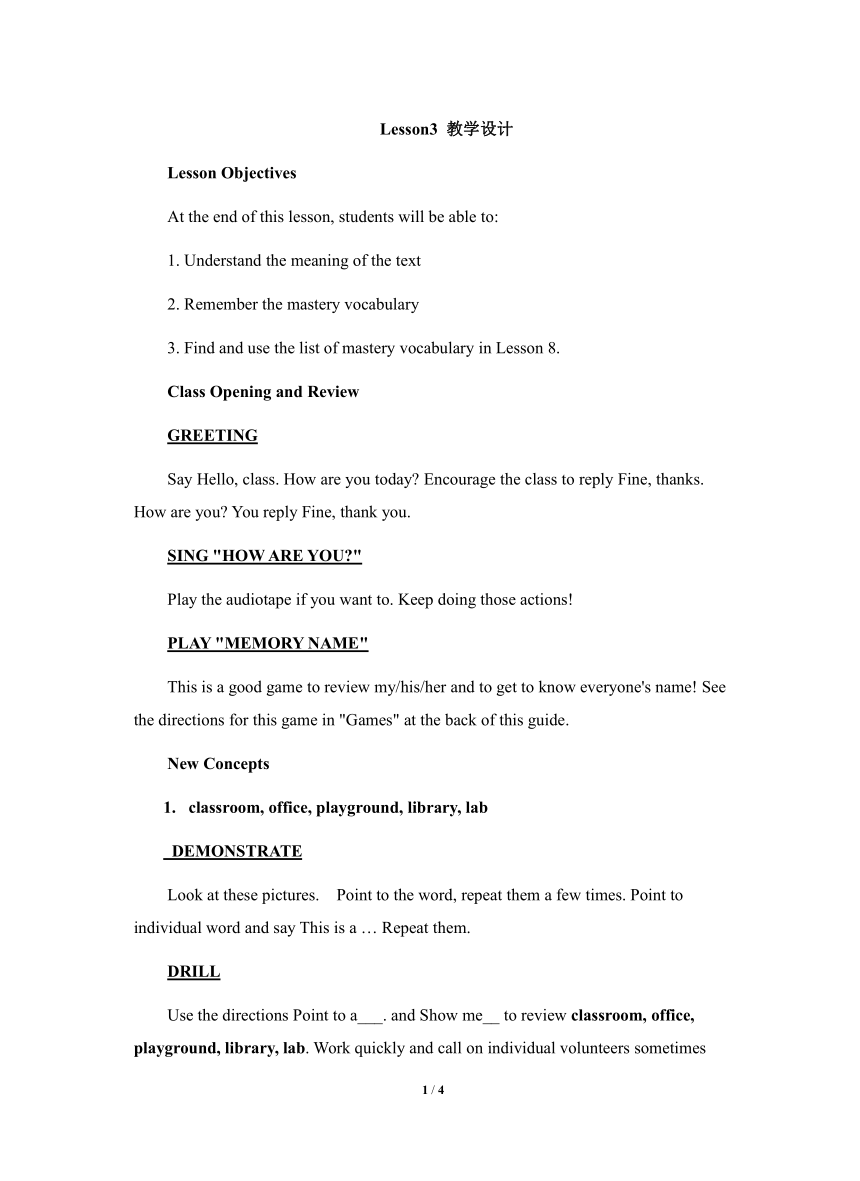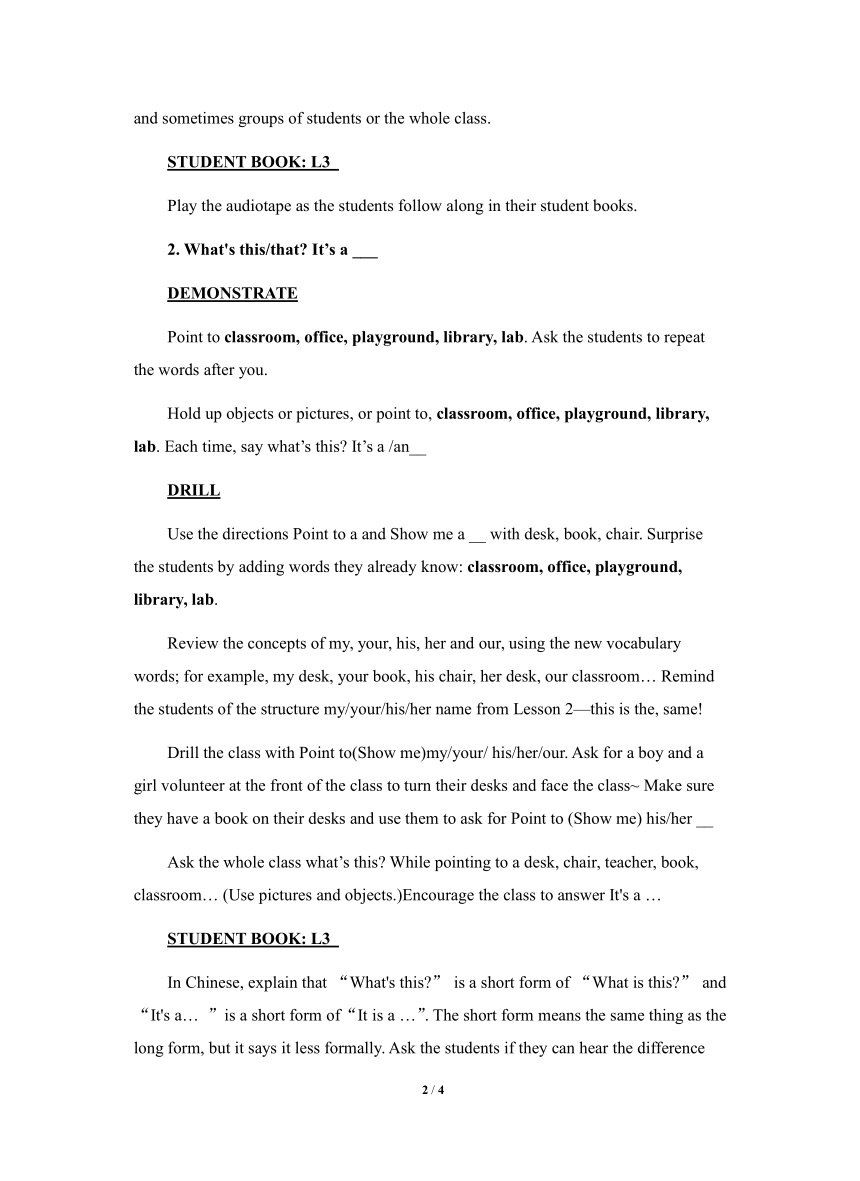冀教版七年级上Unit 1 School and friends Lesson 3 Welcome to Our School 教案
文档属性
| 名称 | 冀教版七年级上Unit 1 School and friends Lesson 3 Welcome to Our School 教案 |

|
|
| 格式 | doc | ||
| 文件大小 | 33.0KB | ||
| 资源类型 | 教案 | ||
| 版本资源 | 冀教版 | ||
| 科目 | 英语 | ||
| 更新时间 | 2022-06-09 22:01:16 | ||
图片预览


文档简介
Lesson3 教学设计
Lesson Objectives
At the end of this lesson, students will be able to:
1. Understand the meaning of the text
2. Remember the mastery vocabulary
3. Find and use the list of mastery vocabulary in Lesson 8.
Class Opening and Review
GREETING
Say Hello, class. How are you today Encourage the class to reply Fine, thanks. How are you You reply Fine, thank you.
SING "HOW ARE YOU "
Play the audiotape if you want to. Keep doing those actions!
PLAY "MEMORY NAME"
This is a good game to review my/his/her and to get to know everyone's name! See the directions for this game in "Games" at the back of this guide.
New Concepts
1. classroom, office, playground, library, lab
DEMONSTRATE
Look at these pictures. Point to the word, repeat them a few times. Point to individual word and say This is a … Repeat them.
DRILL
Use the directions Point to a___. and Show me__ to review classroom, office, playground, library, lab. Work quickly and call on individual volunteers sometimes and sometimes groups of students or the whole class.
STUDENT BOOK: L3
Play the audiotape as the students follow along in their student books.
2. What's this/that It’s a ___
DEMONSTRATE
Point to classroom, office, playground, library, lab. Ask the students to repeat the words after you.
Hold up objects or pictures, or point to, classroom, office, playground, library, lab. Each time, say what’s this It’s a /an__
DRILL
Use the directions Point to a and Show me a __ with desk, book, chair. Surprise the students by adding words they already know: classroom, office, playground, library, lab.
Review the concepts of my, your, his, her and our, using the new vocabulary words; for example, my desk, your book, his chair, her desk, our classroom… Remind the students of the structure my/your/his/her name from Lesson 2—this is the, same!
Drill the class with Point to(Show me)my/your/ his/her/our. Ask for a boy and a girl volunteer at the front of the class to turn their desks and face the class~ Make sure they have a book on their desks and use them to ask for Point to (Show me) his/her __
Ask the whole class what’s this While pointing to a desk, chair, teacher, book, classroom… (Use pictures and objects.)Encourage the class to answer It's a …
STUDENT BOOK: L3
In Chinese, explain that “What's this ” is a short form of “What is this ” and “It's a… ” is a short form of “It is a …”. The short form means the same thing as the long form, but it says it less formally. Ask the students if they can hear the difference between the short and long form of both phrases. Have the class repeat What's this /What is this And It's a ___. /It is a few times.
Explain that the best way to answer the short-form question is with the short-form answer: What’s this It's a. The long-form answer goes best with the long-form question: What is this/ that It is a ___.
Let the students practice answering the long and short question with the long or short answer. Tell them to listen carefully to hear the difference and to try to give the matching answer.
Play the audiotape as the students follow along in heir student books.
PLAY "WHAT'S THIS "
The students should play in pairs~
Teaching Tip
In your class, you should try to use English as much as possible. Sometimes, however, you will find translating a particular word or phrase very helpful. Always let the students hear the English word or phrase first. Then, if you need to, give a translation.
You might choose to use Chinese to quickly explain directions for an activity or game. You might use Chinese when you want your students to discuss the meaning of a story or dialogue if they do not know enough English to express what they understand. Use Chinese when your own English is not good. Sometimes you may need to use Chinese if your own English is slow. It is important to keep the pace of the class brisk.
Let’s Do It
Class Closing
Here are the homework recommendations for this lesson:
.the remaining Let’s Do It
.the reading for the next lesson in the student book
1 / 4
Lesson Objectives
At the end of this lesson, students will be able to:
1. Understand the meaning of the text
2. Remember the mastery vocabulary
3. Find and use the list of mastery vocabulary in Lesson 8.
Class Opening and Review
GREETING
Say Hello, class. How are you today Encourage the class to reply Fine, thanks. How are you You reply Fine, thank you.
SING "HOW ARE YOU "
Play the audiotape if you want to. Keep doing those actions!
PLAY "MEMORY NAME"
This is a good game to review my/his/her and to get to know everyone's name! See the directions for this game in "Games" at the back of this guide.
New Concepts
1. classroom, office, playground, library, lab
DEMONSTRATE
Look at these pictures. Point to the word, repeat them a few times. Point to individual word and say This is a … Repeat them.
DRILL
Use the directions Point to a___. and Show me__ to review classroom, office, playground, library, lab. Work quickly and call on individual volunteers sometimes and sometimes groups of students or the whole class.
STUDENT BOOK: L3
Play the audiotape as the students follow along in their student books.
2. What's this/that It’s a ___
DEMONSTRATE
Point to classroom, office, playground, library, lab. Ask the students to repeat the words after you.
Hold up objects or pictures, or point to, classroom, office, playground, library, lab. Each time, say what’s this It’s a /an__
DRILL
Use the directions Point to a and Show me a __ with desk, book, chair. Surprise the students by adding words they already know: classroom, office, playground, library, lab.
Review the concepts of my, your, his, her and our, using the new vocabulary words; for example, my desk, your book, his chair, her desk, our classroom… Remind the students of the structure my/your/his/her name from Lesson 2—this is the, same!
Drill the class with Point to(Show me)my/your/ his/her/our. Ask for a boy and a girl volunteer at the front of the class to turn their desks and face the class~ Make sure they have a book on their desks and use them to ask for Point to (Show me) his/her __
Ask the whole class what’s this While pointing to a desk, chair, teacher, book, classroom… (Use pictures and objects.)Encourage the class to answer It's a …
STUDENT BOOK: L3
In Chinese, explain that “What's this ” is a short form of “What is this ” and “It's a… ” is a short form of “It is a …”. The short form means the same thing as the long form, but it says it less formally. Ask the students if they can hear the difference between the short and long form of both phrases. Have the class repeat What's this /What is this And It's a ___. /It is a few times.
Explain that the best way to answer the short-form question is with the short-form answer: What’s this It's a. The long-form answer goes best with the long-form question: What is this/ that It is a ___.
Let the students practice answering the long and short question with the long or short answer. Tell them to listen carefully to hear the difference and to try to give the matching answer.
Play the audiotape as the students follow along in heir student books.
PLAY "WHAT'S THIS "
The students should play in pairs~
Teaching Tip
In your class, you should try to use English as much as possible. Sometimes, however, you will find translating a particular word or phrase very helpful. Always let the students hear the English word or phrase first. Then, if you need to, give a translation.
You might choose to use Chinese to quickly explain directions for an activity or game. You might use Chinese when you want your students to discuss the meaning of a story or dialogue if they do not know enough English to express what they understand. Use Chinese when your own English is not good. Sometimes you may need to use Chinese if your own English is slow. It is important to keep the pace of the class brisk.
Let’s Do It
Class Closing
Here are the homework recommendations for this lesson:
.the remaining Let’s Do It
.the reading for the next lesson in the student book
1 / 4
同课章节目录
- Unit 1 School and friends
- Lesson 1 Hello!
- Lesson 2 Teacher and Students
- Lesson 3 Welcome to Our School
- Lesson 4 What Is It?
- Lesson 5 May I Have a Book?
- Lesson 6 Things for School
- Unit 2 Colours and Clothes
- Lesson 7 Jenny's New Skirt
- Lesson 8 Danny's Favourit Colou
- Lesson 9 Whose Coat Is This?
- Lesson 10 Clothes for a Cold Day
- Lesson 11 Clothes around the World
- Lesson 12 Let's Go Shopping!
- Unit 3 Body Parts and Feelings
- Lesson 13 Body Parts
- Lesson 14 Colours and Feelings
- Lesson 15 Tall or Short
- Lesson 16 Happy or Sad
- Lesson 17 Seeing a Docto
- Lesson 18 We All Look Different!
- Unit 4 Food and Restaurants
- Lesson 19 Time for Breakfast!
- Lesson 20 I Like the Supermarket!
- Lesson 21 At the Market
- Lesson 22 In the Restaurant
- Lesson 23 The Corner Store
- Lesson 24 Eat Good Food!
- Unit 5 Family and Home
- Lesson 25 Jenny's Family
- Lesson 26 Li Ming's Family
- Lesson 27 Danny at Home
- Lesson 28 A Family Picnic
- Lesson 29 A Birthday Card
- Lesson 30 Grandma's Birthday Party
- Unit 6 Let's Go!
- Lesson 31 Let's Go to the Bookstore!
- Lesson 32 At the Supermarket
- Lesson 33 Let's Go to the Zoo!
- Lesson 34 On the Farm
- Lesson 35 Let's Go to the Museum!
- Lesson 36 Let's Go to the Movie Theatre!
- Unit 7 Days and Months
- Lesson 37 Seasons and Weathe
- Lesson 38 Nick's Busy Month
- Lesson 39 A Class Calenda
- Lesson 40 When Is Your Birthday?
- Lesson 41 Holidays
- Lesson 42 Happy Holidays!
- Unit 8 Countries around the world
- Lesson 43 Directions
- Lesson 44 Jack's Goodbye Party
- Lesson 45 China
- Lesson 46 Canada and the U.S.
- Lesson 47 The U.K. and Australia
- Lesson 48 English-Speaking Countries
